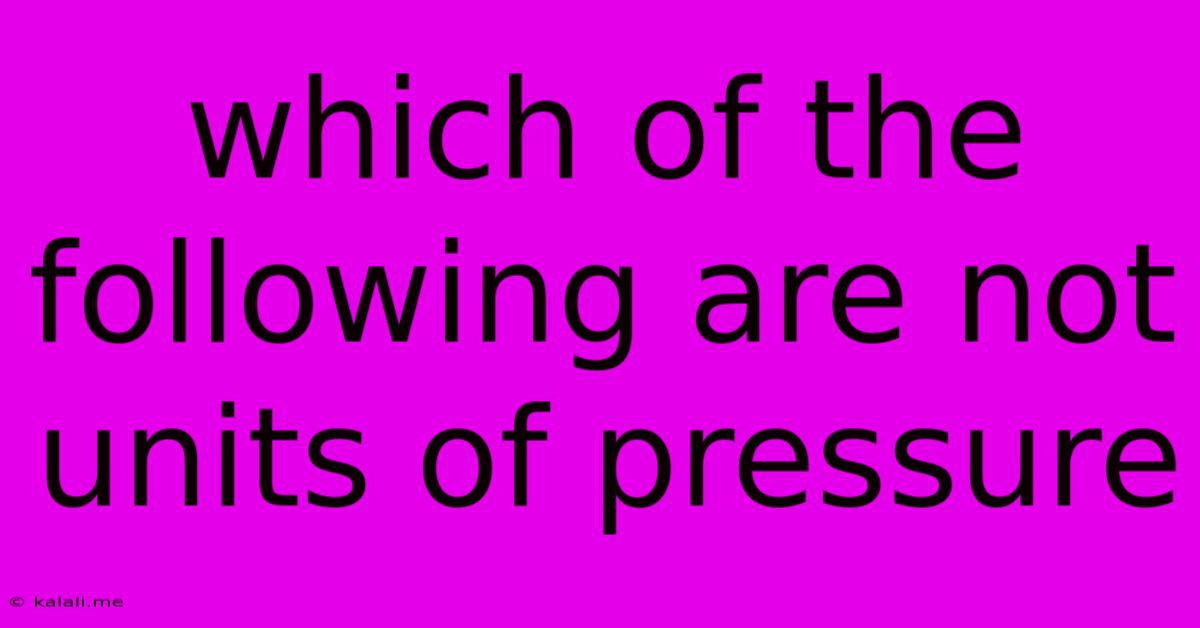Which Of The Following Are Not Units Of Pressure
Kalali
Jun 13, 2025 · 2 min read

Table of Contents
Which of the Following Are Not Units of Pressure?
Pressure, a fundamental concept in physics and engineering, describes the force applied perpendicularly to a surface area. Understanding its units is crucial for accurate calculations and interpretations. This article will delve into common pressure units, highlighting those that don't measure pressure. We'll explore the relationships between various units and clarify any potential confusion.
Understanding Pressure Units: A Quick Overview
Before identifying non-pressure units, let's establish a foundation. Pressure is fundamentally force per unit area. Therefore, units of pressure are derived from units of force and area. Common units include:
- Pascals (Pa): The SI unit of pressure, defined as one newton per square meter (N/m²). This is the standard and most widely used unit in scientific and engineering contexts.
- Atmospheres (atm): Represents the average atmospheric pressure at sea level.
- Bars (bar): A metric unit of pressure, often used in meteorology and other fields.
- Millimeters of mercury (mmHg) or torr: Historically significant, these units represent the height of a mercury column in a barometer.
- Pounds per square inch (psi): Commonly used in engineering, especially in the United States.
Identifying Non-Pressure Units
Now, let's address the core question: which units are not used to measure pressure? The answer depends on the context, but several units are clearly unsuitable:
- Joules (J): This is the SI unit of energy, not pressure. While both involve force and distance, energy is a scalar quantity, while pressure is a scalar quantity that depends on the area where the force is applied. They are fundamentally different concepts.
- Watts (W): This is the SI unit of power, representing the rate of energy transfer. Power is the rate of doing work, unlike pressure which is force per unit area.
- Coulombs (C): The unit of electric charge. Completely unrelated to pressure.
- Newtons (N): While Newtons are a unit of force (a component of pressure), they are not a unit of pressure themselves. Pressure is force per unit area. Simply stating a force does not define pressure.
- Meters (m) or Cubic Meters (m³): These are units of length and volume respectively, unrelated to pressure's definition of force per unit area.
- Kelvin (K): The SI unit of thermodynamic temperature. Temperature influences pressure in some cases (Ideal Gas Law), but temperature itself is not a unit of pressure.
Common Mistakes and Clarifications:
Often, confusion arises because many pressure units are derived from other units. Remember, the crucial aspect is the ratio of force to area. Simply having force or area units doesn't mean it measures pressure.
Conclusion:
Understanding pressure units is vital for numerous scientific and engineering applications. While many units might seem related, it's important to recognize their fundamental differences. By understanding the definition of pressure (force per unit area), you can easily distinguish between units that measure pressure and those that do not. Remembering this distinction will greatly improve your accuracy and comprehension in relevant fields.
Latest Posts
Latest Posts
-
Is A Touchscreen An Input Or Output Device
Jun 14, 2025
-
Which Word Is An Antonym Of Abominable
Jun 14, 2025
-
Each Of Three Equal Capacitors In Series Has
Jun 14, 2025
-
Least Common Multiple Of 40 And 15
Jun 14, 2025
-
Brittle Vs Ductile Stress Strain Curve
Jun 14, 2025
Related Post
Thank you for visiting our website which covers about Which Of The Following Are Not Units Of Pressure . We hope the information provided has been useful to you. Feel free to contact us if you have any questions or need further assistance. See you next time and don't miss to bookmark.